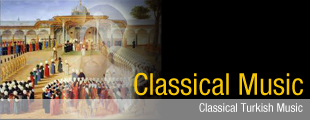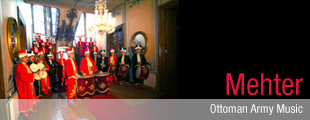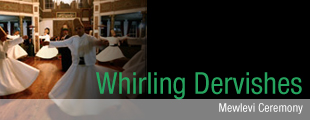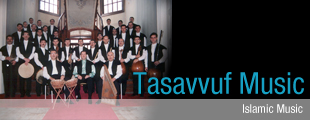

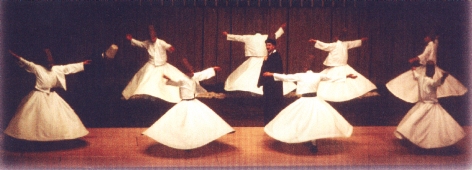 An atmosphere of reverent silence and tranquillity prevail in the Semahane (hall where the Sema is performed). On the left there is a red sheepskin or post, in the centre, a circle of white sheepskins where the dancers, semazen will sit, on the right the mutribhane, the singers and musicians' section. One after another the musicians and dancers enter the hall, bow towards the red post and take their place. The dancers hold their arms folded across their breasts with the left hand on the right shoulder and the right hand on the left shoulder, the position of humility or niyaz. When everyone is in their place, the Sheikh or Post-Nisheen, the one who occupies the post, enters the hall, bowing first in salutation to the red post, then to the musicians and the dancers.Between the red post and the musicians' section there is an imaginary line which only the Shaikh, who knows the path to divine reality, treads. This line is called the Equator, hatti istiva. The Shaikh walks with deliberate steps towards the red post, which he again salutes. The red colour of the sheepskin post symbolises the manifestation of God to man, tajelli, the Shaikh represents the venerable Mevlana, Muhammed Jalaluddin Rumi. The Equator divides the sema hall into two parts. The right side is descent and the material realm, the left side ascent and the spiritual realm.
An atmosphere of reverent silence and tranquillity prevail in the Semahane (hall where the Sema is performed). On the left there is a red sheepskin or post, in the centre, a circle of white sheepskins where the dancers, semazen will sit, on the right the mutribhane, the singers and musicians' section. One after another the musicians and dancers enter the hall, bow towards the red post and take their place. The dancers hold their arms folded across their breasts with the left hand on the right shoulder and the right hand on the left shoulder, the position of humility or niyaz. When everyone is in their place, the Sheikh or Post-Nisheen, the one who occupies the post, enters the hall, bowing first in salutation to the red post, then to the musicians and the dancers.Between the red post and the musicians' section there is an imaginary line which only the Shaikh, who knows the path to divine reality, treads. This line is called the Equator, hatti istiva. The Shaikh walks with deliberate steps towards the red post, which he again salutes. The red colour of the sheepskin post symbolises the manifestation of God to man, tajelli, the Shaikh represents the venerable Mevlana, Muhammed Jalaluddin Rumi. The Equator divides the sema hall into two parts. The right side is descent and the material realm, the left side ascent and the spiritual realm.
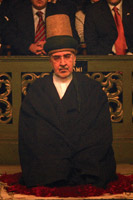 THE NAAT
THE NAAT
When everyone is seated the Naat, a poem expressing love and respect for the Prophet Muhammed, may peace be upon him, is recited. The poem was written by Mevlana, the music by Buhurizade Mustafa Itri (1640-1712). This work is chanted in the rast tonal mode, makam. After the Naat, the small kettle drums, kudum are struck a few times. This sound is a symbol for Allah's command, 'BE!' Quran, Surah 36, Ayah 82: 'Verily, when He intends a thing, His command is be and it is!'
REED FLUTE IMPROVISATION
The ney prelude begins. The flautist transposes from the rast tonal mode to the mode of the following ceremony. This represents the Archangel Israfil trumpeting the Sur, the sound heralding the Resurrection and Day of Judgement. It also evokes the breath which gives all creatures life.
PESHREV
 After the ney prelude, an instrumental work called the peshrev composed in the tonal mode of the ceremony and played in the 28 beat devrikebir rhythmic pattern begins. With the first beat of the peshrev the Shaikh and the dancers bow to the floor, strike it with their hands, and rise to their feet signifying how everything comes into being following Allah's command, 'Be!' At the same time it represents the dead rising from the grave.
After the ney prelude, an instrumental work called the peshrev composed in the tonal mode of the ceremony and played in the 28 beat devrikebir rhythmic pattern begins. With the first beat of the peshrev the Shaikh and the dancers bow to the floor, strike it with their hands, and rise to their feet signifying how everything comes into being following Allah's command, 'Be!' At the same time it represents the dead rising from the grave.
THE SULTAN VELED CYCLE
While the instrumentalists play the peshrev, the Shaikh and the dancers circle the hall three times. This circumambulation symbolises elevation from the material realm into the realm of spirit. The three circuits stand for the three levels of knowledge known in sufic teaching as ilm al-yaqin, ayn al-yaqin and haqq al-yaqin (knowing, seeing, becoming). This walk shows how the progress on the path to Truth and Reality can only be realised by trusting a guide who knows the way. When the Shaikh and the dancers pass before the red post they salute one another with the humble bow, the niyaz. This expresses the salutation of brother to brother, soul to soul. During this salutation the right hand is placed under the cloak over the heart and the feet crossed with the right toes over the left toes. The niyaz is also made on reaching the opposite extreme of the equator. Finally the Shaikh takes his place at the red post and the Sultan Veled Cycle is ended. With a short musical interlude the ceremony begins.
HE FIRST SELAM SELAM - SALUTATION OF PEACE
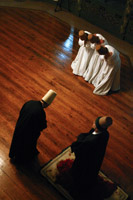 This section of the ceremony is realised with choral and instrumental music in 8 or 14 beat rhythm. As the music begins, the dancers remove their black khirka (long cape with wide arms) symbolising spiritual birth. As they stand in the humble niyaz, their posture suggests the number one, symbol of Allah's Oneness. The dance master, Semazenbashi goes before the Shaikh and requests permission to commence with the Sema. The dancers join in this salutation. When the Shaikh gives permission, the dancers one by one pass before him to kiss his right hand. He in turn kisses their tall headgear, sikke, thus opening the Sema. During the Sema the dancers hold their arms with right palm facing up and the left down. The narrowed eyes gaze upon the left thumb. This posture symbolizes the fair distribution to others of that which is received from God. As they whirl from right to left, the dancers inwardly repeat with every turn AL-LAH. The dance master moves around the arena, directing the dancers. This section of the Sema, the First Selam, is the level of Divine Law in Sufism, Shariyah, that is to say, borne into Reality through knowledge, the human being becomes aware of his Exalted Creator and his own condition of servanthood. As this Selam comes to an end, the Shaikh strides forward from the red post to recite supplications and announce his permission to proceed with the next Selam. When the last dancer has begun to turn, he exchanges humble bows with the dance master and moves back to the red sheepskin.
This section of the ceremony is realised with choral and instrumental music in 8 or 14 beat rhythm. As the music begins, the dancers remove their black khirka (long cape with wide arms) symbolising spiritual birth. As they stand in the humble niyaz, their posture suggests the number one, symbol of Allah's Oneness. The dance master, Semazenbashi goes before the Shaikh and requests permission to commence with the Sema. The dancers join in this salutation. When the Shaikh gives permission, the dancers one by one pass before him to kiss his right hand. He in turn kisses their tall headgear, sikke, thus opening the Sema. During the Sema the dancers hold their arms with right palm facing up and the left down. The narrowed eyes gaze upon the left thumb. This posture symbolizes the fair distribution to others of that which is received from God. As they whirl from right to left, the dancers inwardly repeat with every turn AL-LAH. The dance master moves around the arena, directing the dancers. This section of the Sema, the First Selam, is the level of Divine Law in Sufism, Shariyah, that is to say, borne into Reality through knowledge, the human being becomes aware of his Exalted Creator and his own condition of servanthood. As this Selam comes to an end, the Shaikh strides forward from the red post to recite supplications and announce his permission to proceed with the next Selam. When the last dancer has begun to turn, he exchanges humble bows with the dance master and moves back to the red sheepskin.
THE SECOND SELAM
Immediately following the abrupt end of the music in the First Selam, the Second Selam commences. The 9 beat rhythmic pattern, evfer is somewhat slower. This change of rhythm compels the listener to contemplation. When the music ceases, the dancers also abruptly cease turning, standing shoulder to shoulder in twos and threes in the humble niyaz posture, they face the centre of the sema hall. After the salutation they pass one by one before the Shaikh as in the First Selam. This time, however, they immediately begin turning without kissing the Shaikh's hand. This section shows the level of the inner path of Sufism, Tariqah; that is to say, being in a state of awesome wonder in the presence of Allah's might on witnessing the grandeur and harmony of creation.
THE THIRD SELAM
 In this Selam three different rhythms and a gradually increasing tempo are employed. The first is the 28 beat measure rhythm, devrikebir, the second the 10 beat measure rhythm, aksak semai, and finally the six beat measure rhythm yuruk semai. During the final six beat sections the tempo slowly accelerates, increasing the music's tension. The dancers begin this Selam as in the Second. This portrays the level of Truth and Reality, Haqiqah; awe and obligation turn into love, and intellect is sacrificed to love. This is absolute submission; it is union with Allah, annihilation in the Beloved. As with Nirvana or Osiris, the object of this level is to become nothing, "fena fillah". As for the highest degree in Islam, it is the station of servanthood, which is attained in the following Selam. It means cessation of the self to then come to existence in Allah, "baqa billah".
In this Selam three different rhythms and a gradually increasing tempo are employed. The first is the 28 beat measure rhythm, devrikebir, the second the 10 beat measure rhythm, aksak semai, and finally the six beat measure rhythm yuruk semai. During the final six beat sections the tempo slowly accelerates, increasing the music's tension. The dancers begin this Selam as in the Second. This portrays the level of Truth and Reality, Haqiqah; awe and obligation turn into love, and intellect is sacrificed to love. This is absolute submission; it is union with Allah, annihilation in the Beloved. As with Nirvana or Osiris, the object of this level is to become nothing, "fena fillah". As for the highest degree in Islam, it is the station of servanthood, which is attained in the following Selam. It means cessation of the self to then come to existence in Allah, "baqa billah".
THE FOURTH SELAM
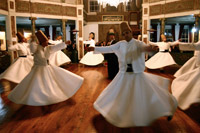
The music in this section is also composed with the nine beat measure of the evfer rhythm. It is played very slowly, as if one had been abruptly taken from the rhythmic intoxication of the previous Selam and left alone with reality. The dancers begin the whirling of the Sema as in the previous Selams. However, in contrast to the previous Selams, they whirl where they stand, without moving around the hall. The Shaikh and the dance master join in this Sema. However, they do not remove their black cloaks. Grasping their cloaks with the left hand at waist level and the lapel with the right hand, opening it slightly, they do the Sema. What is expressed here is the highest rank in Islam, the station of Gnosis, "Marifah". That is to say, it portrays the completion of the spiritual journey, where, content with his destiny, the human being turns to the obligation he was created for, namely, his servanthood. As the poet admonishes: Though knowing all stations of the spirit, even attaining, Do not forsake your servanthood. Most exalted is that service, the highest rank. But those who know and those who don't are not equals. At the conclusion of this Selam the instrumentalists play pieces called the Last Peshrev (eight beat measures) and Last Yuruksemai (six beat measure). The music continues in an exuberant mood as heard during the end of the Third Selam, concluding in the Yuruksemai section with the improvisation of a single musician. With this final solo, the hearts, quickened and exuberant in the joy of servanthood, are slowly quieted. When the Shaikh returns to the red post, the music ceases and recitation of the Noble Quran begins.
KUR'AN-I KERİM
As the reading of the Holy Quran begins, semazens (whirling dervishes) leave sema (the dance) by withdrawing to semahane's edge and sitting down the place they stand. While listening the Quran like this way, one of them make everyone wear their khirkas. The ayet (verse of the Quran) of ''East and the West is Allah's. You will see Allah's face in every side you turn. Because, Allah's compassion and blessing is spacious and he is the one who knows everything'' is read. (Bakara-115).
NİYAZ (PRAYER)
Once the reading of Holy Quran has finished, post-nisheen says ''Fatiha''. After this Fatiha Sura has been secretly read, Sheikh, mutrıb (musicians) and the semanzens (whirling dervishes) stand up. Sometimes, a special prayer in Persian, called ''Mevlevi Gülbankı'' is read by the Semazenbaşı (master of the whirling dervishes). All of the prophets, the people died in the way of Allah and all the beleivers and our salvation are mentioned in this prayer. Fatiha Sura is again being read after the prayer and finished with the ''Let's say Hu'' expression of the post-nisheen. All of the mutrıb and the semazens say "Hu" with a high and intone voice.
FINAL
At the final, the post-nisheen bows through both the semazens and the mutrıb. Semahane is left by bowing through Sheikh's Post with tranquility, humility, silence and calmness.
Text: Özata Ayan
Photos: Bülent Selçuk
